Goalkeeping 1v1
A goalkeeper must be quick to deal with a 1v1 situation. Not just quick footed, but quick thinking too. This training session creates just the kind of 1v1 situations needed to rehearse the skills and decision-making needed to deal with an oncoming opponent.

| Area | Up to 60×40 yards |
| Equipment | Balls, bibs, cones, 2 small goals, 2 full size goals |
| No. of Players | Up to 12 players + 2 goalkeepers |
| Session Time | Total: 70mins, Practice 1, 2 & 3: 10mins each, Practice 4: 15mins, Practice 5: 25mins |
A goalkeeper must be quick to deal with a 1v1 situation. Not just quick footed, or quick with his hands, or quick off his line, but he must be quick thinking too – he needs to make the right decision at the right time. Whether it’s to block, spread, feint to dive, or dive for real at the feet of an attacker, the keeper must commit to a course of action. This training session creates just the kind of 1v1 situations needed to rehearse the skills and decision-making needed to deal with an oncoming opponent.
What do I get the players to do?
Practice 1: central approaches
Start the session with the goalkeeper working on facing central approaches from an attacker. Set up an area of 10x10 yards with the keeper defending a two-yard goal and an attacker starting from a cone opposite the centre of the goal, as shown [1].
Play starts with the keeper rolling the ball out to his opponent, who will either try to dribble around the keeper or elect to take a shot.
Alternate this practice with Practice 2 in five-minute blocks for 20 minutes.
1
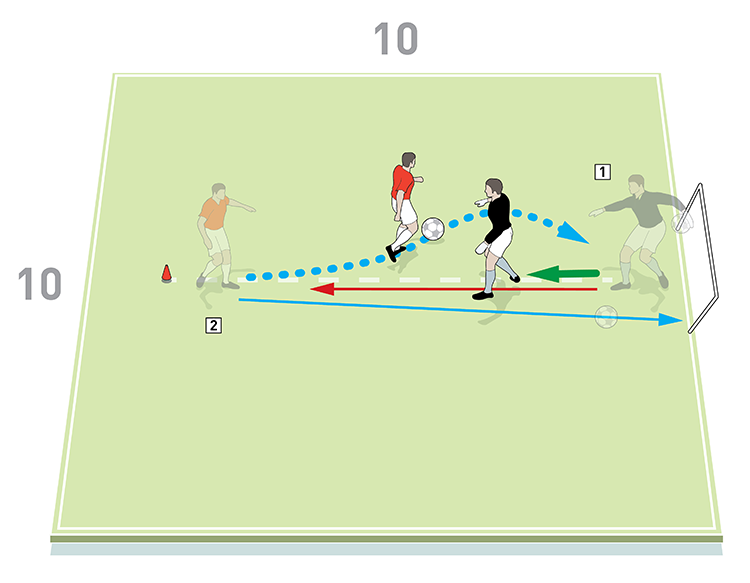
2. The attacker can try to score by either dribbling around the keeper or shooting. The blue arrows show his options
Practice 2: wide approaches
To give your keeper experience of dealing with wide approaches, use the same set-up and principles as Practice 1, but this time the attacker starts from a wide position, as shown [2]. Make sure you alternate the side of attack.
Play again starts with the keeper rolling the ball out to the attacker, who will either dribble at the keeper or who will try to score with a shot. Alternate this practice with Practice 1 in five-minute blocks for 20 minutes.
2
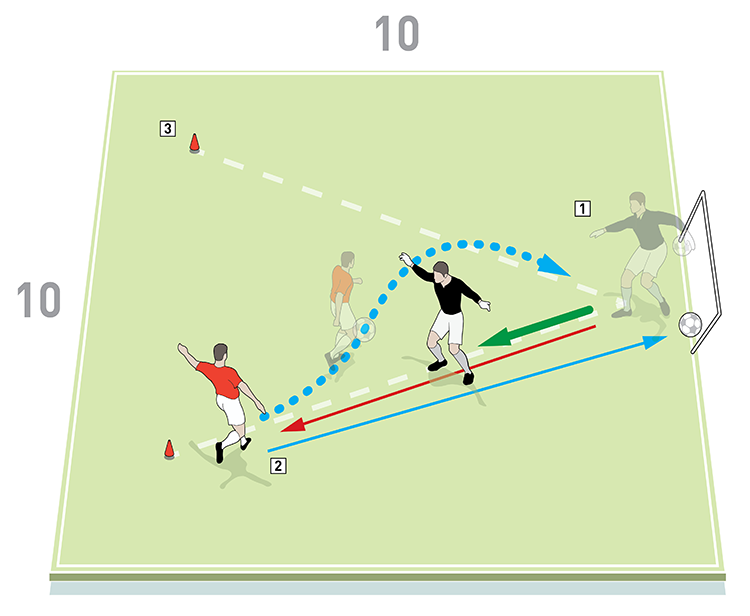
2. The attacker’s first touch will help the keeper tell whether he plans to dribble or shoot. The blue arrows show the attacker’s options
3. Alternate the side of attack changing from one starting cone to another
What are the key things to look out for in Practices 1 and 2?
To be successful, it’s important that the keeper assesses the first touch of the attacker, which should give a hint as to whether he will dribble or shoot. Make sure the keeper advances towards the attacker to narrow the angle and put him under pressure. He should make himself big but adopt a low and ready position, staying committed and on his feet until he senses a chance to win the ball.
Look for him to use the full range of tactics and tricks to delay the opponent or force him away from goal – for example, the keeper could feint to dive in order to fool the attacker into showing his hand.
When facing a wide attack, encourage the keeper to make the play predictable by using the touchline to divert the ball out of play if possible.
What do I get the players to do next?
Practice 3: saving at feet 3v1
Use the same 10x10-yard area with three attackers and one goalkeeper, but this time there is no goal. Play starts with the three outfield players passing the ball around the keeper, as shown [3]. The keeper should either try to win the ball by forcing a mistake or divert it out of play. As the practice develops, the three attackers should be moving around the area to escape the goalkeeper. As it’s a tough exercise for the keeper, play for 10 minutes but rest for 30 seconds every three minutes, or play for three interceptions and switch keepers.
3
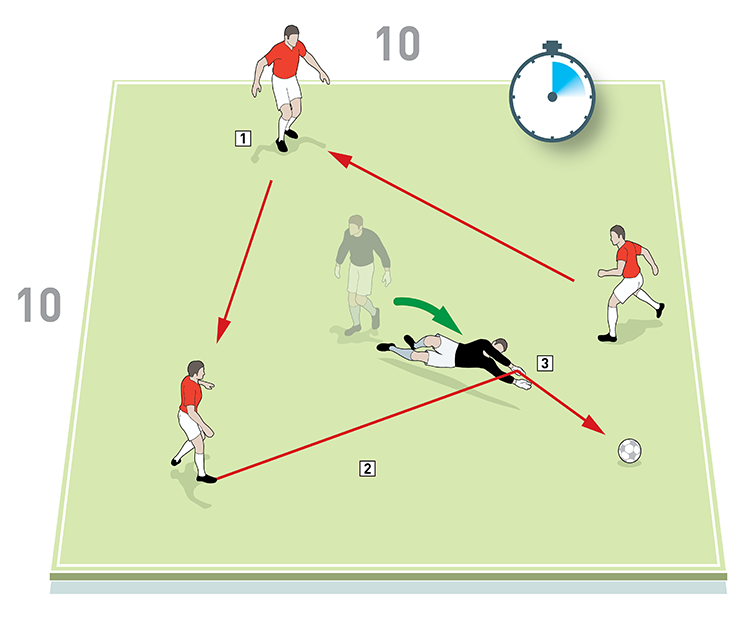
2. The keeper should try to stay on his feet and be patient while trying to force errors
3. When certain he can get the ball, he should commit to an interception
What are the key things to look out for in Practice 3?
This should help the keeper focus his decision making, so look for him to make the correct technical blocking decision for each situation. He should try to close down the player with the ball and put him under pressure, adopting a low but ready position with his arms down and his hands alongside his lower legs.
The keeper should assess each move by his opponent and look for miscontrol, poor touch, or an incorrect weight of pass, making sure he is patient and stays on his feet until he feels he can win the ball. Also look for him using an upright or spreading block, or for him to threaten the ball carrier with a feint to dive, forcing the ball into tight spaces.
What do I get the players to do next?
Practice 4: understanding through balls
Use just under half a full pitch, positioning a goal and a goalkeeper in their normal position at one end and mark out a 10x15-yard box between the penalty area and the centre circle. Split the outfield players into a team of four attackers and a team of two defenders, who play a 4v2 in the marked out box. A recovering defender is stationed in a position that allows the attackers to remain in an onside position, as shown [4].
Play starts with the attackers, who pass the ball around the small box to keep it away from the defenders. After three passes, one attacker can break free and attack the goal – but once he leaves the box to start his attack, the recovering defender is allowed to run to challenge or to defend the goal behind the keeper.
4
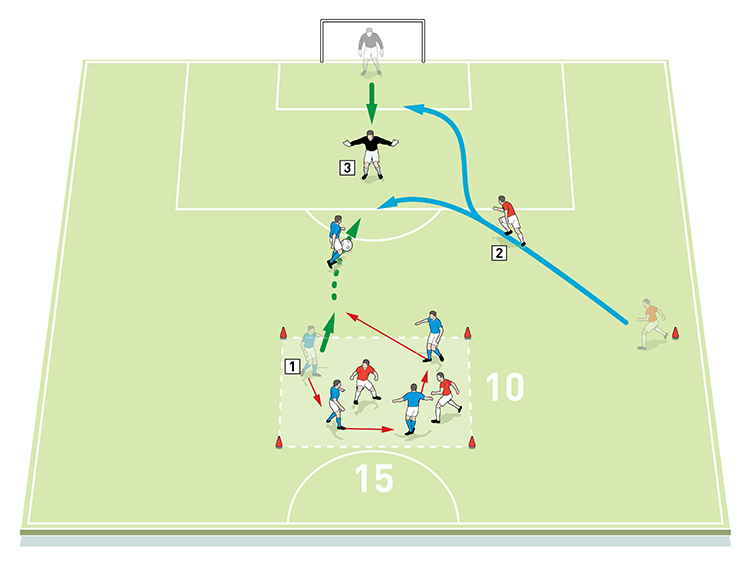
2. The recovering defender can go when the attacker breaks free
3. The keeper should adopt a good starting position that is advanced enough to win a heavy pass but deep enough not to be chipped
You can progress this by allowing more than one attacker to break out of the box, so they can combine to attack. This practice can be used with the box in central areas and the recovering defender slightly out wide, as shown, or in a wider area with the recovering defender more central.
What are the key things to look out for in Practice 4?
Look for your keeper to adopt a good starting position, which is advanced enough to win a heavy or misplaced pass but deep enough not to be chipped.
Communication with the recovering defender is vital, as is decision making – the keeper must decide whether the defender is best placed to deal with the attacker first or whether he will need to make a positive intervention himself, either by delaying the attack, saving a shot, spreading, or blocking. A quick decision is imperative as there is a chance the keeper could get to the ball first and rush the attacker. However, if the attacker looks to be in good control of the ball, moving with caution might be a better option.
How do I progress the session?
Practice 5: break through
This progression encourages attackers to break free in a small-sided game to create 1v1 situations for the goalkeeper to deal with. Set up an area of 60x40 yards with a goal and a goalkeeper at each end. Divide the pitch into three equal sized areas, as shown [5]. The outfield players play 6v6 in the central zone. The game is directional so the aim is for teams to score past the opposition keeper.
The team in possession must try to play through, around or over the defending team to get one attacking player into a 1v1 situation with the keeper. One attacker can break out of the area as soon as a ball has been played into the final third, and one recovering defender is allowed to go with him to help the keeper.
Play this game for 25 minutes.
5
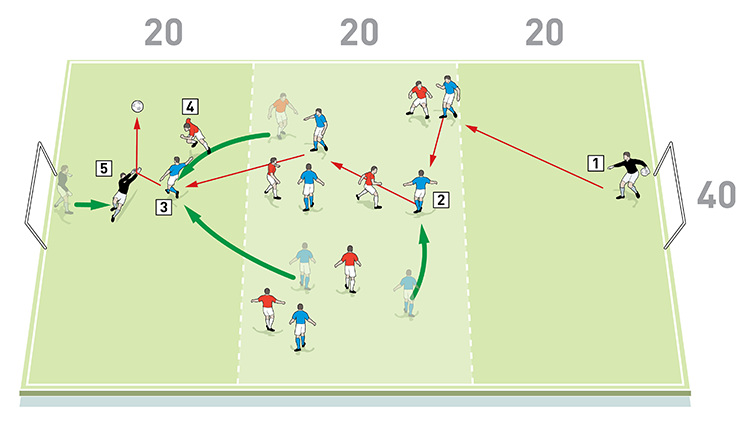
2. Play 6v6 in the centre. The team in possession looks for a chance to play a through ball out of the area
3. As soon as the through ball is played, one attacker can break free and runs onto the pass to attack
4. One defender is allowed to follow the attacker out of the zone to help the keeper
5. Here the keeper commits to coming out to narrow the angle and he dives to save the shot from the striker
What are the key things to look out for in Practice 5?
The goalkeeper must be alert to the danger of a through ball or a shot at any time, and must use good decision making to assess the best way to deal with the developing attack. Look for the keeper to delay or slow the approach of the attacker if needed – he should use a variety of tactics, from spreading and blocking to plunging onto the ball, but above all he should be determined, committed and capable of improvising. He must also stay in communication with his defender.
How would you put this into a game situation?
Play an 11v11 game and instruct your players to be aware of the main coaching points of the session.
Editor's Picks
Attacking transitions
Deep runs in the final third
Using the goalkeeper in build-up play
Intensive boxes drill with goals
Penetrating the final third
Creating and finishing
My philosophy
Pressing initiation
Compact team movement
Coaches' Testimonials

Alan Pardew

Arsène Wenger

Brendan Rodgers

Carlos Carvalhal

José Mourinho

Jürgen Klopp

Pep Guardiola

Roy Hodgson

Sir Alex Ferguson

Steven Gerrard
Coaches' Testimonials

Gerald Kearney, Downtown Las Vegas Soccer Club

Paul Butler, Florida, USA

Rick Shields, Springboro, USA

Tony Green, Pierrefonds Titans, Quebec, Canada
Join the world's leading coaches and managers and discover for yourself one of the best kept secrets in coaching. No other training tool on the planet is written or read by the calibre of names you’ll find in Elite Soccer.
In a recent survey 92% of subscribers said Elite Soccer makes them more confident, 89% said it makes them a more effective coach and 91% said it makes them more inspired.
Get Monthly Inspiration
All the latest techniques and approaches
Since 2010 Elite Soccer has given subscribers exclusive insight into the training ground practices of the world’s best coaches. Published in partnership with the League Managers Association we have unparalleled access to the leading lights in the English leagues, as well as a host of international managers.
Elite Soccer exclusively features sessions written by the coaches themselves. There are no observed sessions and no sessions “in the style of”, just first-hand advice delivered direct to you from the coach.








